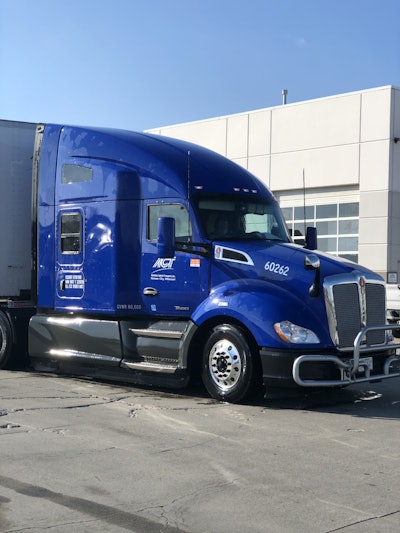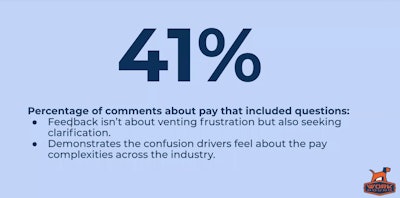
With plenty of freight to be hauled and drivers in short supply, American Central Transport (ACT) in Kansas City, Missouri, has learned the value of taking driver feedback seriously when it comes to reinforcing company values centered around driver pay and work-life balance.
To help improve driver satisfaction and thus improve driver retention, ACT, a dry van hauler, has followed up on driver complaints concerning difficult customers.
“We’re in a really good position right now (to address concerns with customers),” ACT President and Chief Operating Officer Phil Wilt said during a WorkHound webinar this week on driver retention. “We’re oversold every day. Now is the time to get things right.
“If we have a customer that's not adhering to the contract, or their treatment of drivers is not acceptable, or they're not turning the freight as fast as it needs to be, all those things are hurting our drivers and, quite honestly, they're hurting us,” Wilt continued. “And so those are the types things that we get to have conversations about. The (driver) feedback is invaluable because this isn't ACT saying this, it’s what our drivers are saying. And I think that customers really are getting how important, how valuable, drivers are.”
 WorkHound CEO and cofounder Max Farrell said driver complaints around compensation are often mistaken by fleets to be concerns with rate of pay. Companies that strive to clear up complexities around pay, he said, will have greater driver satisfaction.WorkHound
WorkHound CEO and cofounder Max Farrell said driver complaints around compensation are often mistaken by fleets to be concerns with rate of pay. Companies that strive to clear up complexities around pay, he said, will have greater driver satisfaction.WorkHound
“We had a lot of drivers stranded in Texas,” Wilt said. “We don't typically pay when an act of God or weather happens. Very few carriers do. We decided to pay those drivers daily pay. Why? Because we felt it was the right thing to do, because we have to make sure that they are staying in good shape with their family. We've got to respect them. We have to have integrity in our programs. We've got to be accountable for them.”
Wilt said driver feedback through the WorkHound app was positive and that some “were surprised” and “didn’t expect that.”
Leah Shaver, CEO and president at National Transportation Institute, said her company has been busier than ever consulting with shippers and fleets concerned about leveraging driver feedback to improve retention.
“I was approached by three major household name shippers in the last month, reacting and responding to the driver supply concerns and asking many more questions based on benchmarking data and driver feedback, what decisions need to be made, what changes are important and how can they better communicate not only with drivers to solicit their feedback, but also with fleets to make sure that they're treating their drivers fairly,” said Shaver, a panelist on the WorkHound webinar.
Company culture for the long-haul
Fostering a more effective work-life balance as a critical part of company culture is not without its challenges. Wilt said upholding company values so that drivers can have more home time can sometimes mean ending a lucrative deal with an out-of-the-way customer.
“What we're really focused on is tighter, more dense freight,” Wilt explained. “Why? Because that gets us the value of getting a driver home. It's about work-life balance.”
[Related: Same 'ol driver retention problems begging for a fresh approach]
Wilt said the company has been intentional about maintaining its goal of maximizing driver time with family.
“We’ve had to say to customers, ‘Man, it’s been great, but we can’t do business with you anymore. Here’s why.’”
ACT’s goal of chasing down a more effective work-life balance is paying off.
“We've really become more disciplined and there's been a big win in that not only for our drivers, but also for the company,” Wilt said. “We are so much more efficient, so much more effective that it makes our drivers much happier.”
Shaver said it’s important to highlight attractive features of company culture, compensation and key performance indicators, especially at a time when drivers are in high demand.
“I think it's especially key right now when driver supply is net short that communicating your culture and what I refer to as recruiting from the inside out, promoting and applauding your own people, your own changes, your own practices, the things and the people and the activities and the metrics and the KPIs that you're most proud of that attracts new people today,” she said.
“It says that you have a company where the people are important and it, it tells them that they might also be important if they were to join you. So communicating culture today is so key,” Shaver continued.
Strive to clear up misunderstandings about pay
Max Farrell, CEO and co-founder of WorkHound, said that while driver feedback on pay during 2020 is “notoriously negative,” fleets should not assume that driver concerns are always centered around rate of pay.
“Most drivers are commenting about pay because they need assistance navigating complex pay systems,” Farrell said.
“The complexities of how driver pay works causes confusion that is often misunderstood as dissatisfaction,” he continued. “What we know is that when drivers are clear in the understanding about pay and how it works and how much they can expect to be paid, they are more satisfied with their work and ultimately the company they work with.”
 WorkHound CEO and co-founder Max Farrell said recent trends analysis showed that 41% of driver comments included questions seeking clarification related to driver pay.WorkHound
WorkHound CEO and co-founder Max Farrell said recent trends analysis showed that 41% of driver comments included questions seeking clarification related to driver pay.WorkHound
“Between private fleets and for-hire fleets, we track over 125 attributes of the professional driver pay package,” Shaver said. “Some of them overlap. Some of them can become much more expansive when we move into private fleet pay, but ultimately it's a stunning number.”
Attributes are definitely worth noting, Shaver said, particularly for companies that want pay to match their culture.
“I think of those pay attributes, so many of them can lead to unpaid unproductive time, and that's where a lot of the questions and concerns and complaints come in,” Shaver said. “Not only is pay in our industry complex, but there are many things that are considered acceptable, whether it's by shippers, by carriers, by experienced drivers that would not work for the rest of us.”
Wilt said ACT pays its drivers by the mile and leans on driver feedback to clear up any misunderstandings about compensation.
“If we don't have feedback, we don't know really what's going on,” he said. “It helps us identify confusion that a driver might have around a customer or a pay strategy. It helps us with questions that are out there, and I believe we're really good at communicating, but what I've found is no matter how big the communicator you think you are, you have to continue to stay at this.”












